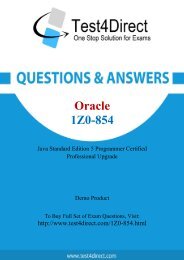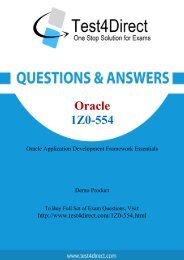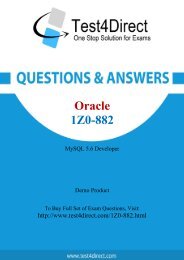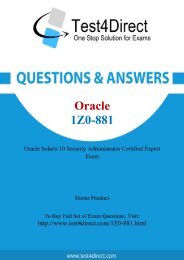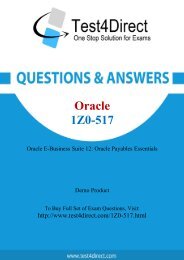1Z0-460 Actual Exam BrainDumps
Test4Direct provides latest PDF questions of Oracle 1Z0-460 exam. You have an opportunity to pass the Oracle 1Z0-460 exam in one go. Test4Direct is most accurate source to prepare Oracle 1Z0-460 exam as your success will become site’s responsibility after purchasing 1Z0-460 exam product. There are also lots of discounts and promotion offers that you can avail. Let’s try a free demo http://www.test4direct.com/1Z0-460.html
Test4Direct provides latest PDF questions of Oracle 1Z0-460 exam. You have an opportunity to pass the Oracle 1Z0-460 exam in one go. Test4Direct is most accurate source to prepare Oracle 1Z0-460 exam as your success will become site’s responsibility after purchasing 1Z0-460 exam product. There are also lots of discounts and promotion offers that you can avail. Let’s try a free demo http://www.test4direct.com/1Z0-460.html
Create successful ePaper yourself
Turn your PDF publications into a flip-book with our unique Google optimized e-Paper software.
Oracle<br />
<strong>1Z0</strong>-<strong>460</strong><br />
Oracle Linux 6 Implementation Essentials<br />
Demo Product<br />
To Buy Full Set of <strong>Exam</strong> Questions, Visit:<br />
http://www.test4direct.com/<strong>1Z0</strong>-<strong>460</strong>.html
Question: 1<br />
Finding a directive issued by your organization listing several important CVEs (Common Vulnerability<br />
and Exposures), you find one for Linux OpenSSH (CVE-2006-5764), which might apply to your oracle<br />
Linux systems. What command would help ensure that a patch has been applied to close this<br />
vulnerability on an Oracle Linux 6 system running OpenSSH server?<br />
A. yum listcves openssh<br />
B. rpm –qa | grep openssh | grep 5794<br />
C. rpm –q - - changelog openssh | grep 5794<br />
D. yum sec – list cves | grep 5794<br />
E. yum sec – list cvesApplied<br />
Question: 2<br />
Answer: C<br />
Explanation:<br />
* The command rpm -q --changelog rpm displays a detailed list of information (updates,<br />
configuration, modifications, etc.) about a specific package. This example shows information about<br />
the package rpm. However, only the last five change entries in the RPM database are listed. All<br />
entries (dating back the last two years) are included in the package itself. This query only works if CD<br />
1 is mounted at /media/cdrom:<br />
rpm -qp --changelog /media/cdrom/suse/i586/rpm-3*.rpm<br />
* Is the patch RPM suitable for my system?<br />
To check this, first query the installed version of the package. For pine, this can be done with<br />
rpm -q pine<br />
pine-4.44-188<br />
Which three parameters of a network interface can you modify by using the NetworkManager tool<br />
on your Oracle Linux 6 system?<br />
A. IPv4 settings<br />
B. IPv6 settings<br />
C. Netconsole settings<br />
D. MTU settings<br />
E. IP Proxy settings<br />
Explanation:<br />
Answer: A, B,D
Note:<br />
1 Right-click the NetworkManager icon in the notification area at the top-right corner of the Red Hat<br />
desktop and click "Edit Connections."<br />
2<br />
Click the "System eth0" connection on the wired tab and click "Edit."<br />
3<br />
Click the "IPv4 Settings" tab.<br />
Question: 3<br />
Which two statements describe the capabilities used with the Unbreakable Enterprise Kernel?<br />
A. Existing Red Hat Enterprise Linux 5 and 6 customers need to reinstall Oracle Linux to use the<br />
Unbreakable Enterprise Kernel.<br />
B. The Unbreakable Enterprise kernel is the default kernel starting with Oracle Linux 5.6.<br />
C. The Unbreakable Enterprise kernel is required when using multithreaded CPUs.<br />
D. Oracle Clusterware, OCFS2, and the Enterprise Manager pack for Linux support are included with<br />
Oracle Linux Basic and Premier support.<br />
E. Switching between the Red Hat Compatible kernel and the Unbreakable Enterprise kernel is<br />
simple process of changing kernels and glibc.<br />
Question: 4<br />
Answer: D, E<br />
Explanation:<br />
* Commercial technical support is available through Oracle's Oracle Linux Support program, which<br />
supports Oracle Linux, and existing RHEL or CentOS installations (i.e. without reinstallation).<br />
Note:<br />
* The Unbreakable Enterprise Kernel Release 2 is Oracle's second major release of its heavily tested<br />
and optimized operating system kernel for Oracle Linux 5 and Oracle Linux 6.<br />
Unbreakable Enterprise Kernel Release 2 is based on the mainline Linux kernel version 3.0.16 and<br />
boasts a wide range of new features and improvements relevant for enterprise workloads.<br />
Incorrect:<br />
Not A, not B: Unbreakable Enterprise Kernel Release 2 can be installed on Oracle Linux 5 Update 8 or<br />
newer, as well as on Oracle Linux 6 Update 2 or newer.<br />
View the exhibits.
<strong>Exam</strong>ine the output of sar command and the top command in the Exhibits. Which statement is the<br />
correct interpretation of this data?<br />
A. The system is running low on swap space and memory.<br />
B. CPU is Idle and the system has plenty of free memory available.<br />
C. The CPU utilization is high and one process is using most of the CPU.<br />
D. The system is idle with very little memory, CPU, and I/O utilization.<br />
Question: 5<br />
Answer: C<br />
Explanation:<br />
From the top exhibit we see that npviewer.gin uses 73.4% of the available CPU.<br />
Note:<br />
* sar - Collect, report, or save system activity information.<br />
* The sar command writes to standard output the contents of selected cumulative activity counters<br />
in the operating system. The accounting system, based on the values in the count and interval<br />
parameters, writes information the specified number of times spaced at the specified intervals in<br />
seconds.<br />
* sar –u 2 5<br />
Report CPU utilization for each 2 seconds. 5 lines are displayed.<br />
Which three steps are involved in the installing Ksplice on servers that will be updated?<br />
A. You have to be logged as user “ksplice” on the server you want to prepare and install Oracle<br />
Ksplice on.<br />
B. The Uptrack package needs access directly or through a proxy to the Oracle public yum repository<br />
(http://public-yum.oracle.com/) to download the required packages for the uptrack-* utilities to be<br />
able to work correctly.<br />
C. Download the install-uptrack script using the “wget –N http://www.ksplice.com/uptrack/installuptrack”<br />
command.<br />
D. You have to be logged in as user “root” on the server you want to prepare and install Oracle ksplice<br />
on.<br />
E. The uptrack package will set up a yum repository (/etc/yum.repos.d/ksplice-uptrack.repo) and<br />
download the required package for the uptrack-* utilities to be able to work correctly.<br />
F. Download the ksplice ISO image from https://edelivery.oracle.com/linux and then run the “sh<br />
install-uptrack” script from the ISO image.<br />
Answer: BCD<br />
Explanation:<br />
B: Your system must have access to the internet to install Ksplice. If you are using a proxy, set the<br />
proxy in your shell:<br />
export http_proxy=http://proxy.company.com:port<br />
export https_proxy=http://proxy.company.com:port<br />
CD: Once you have an access key run the following commands as root, replacing YOUR_ACCESS_KEY<br />
with the access key you received upon sign-up:<br />
wget -N https://www.ksplice.com/uptrack/install-uptrack<br />
sh install-uptrack YOUR_ACCESS_KEY
uptrack-upgrade –y<br />
E: If you'd like Ksplice Uptrack to automatically install updates as they become available, run:<br />
sh install-uptrack YOUR_ACCESS_KEY --autoinstall<br />
in place of the above install-uptrack command, or set "autoinstall = yes" in your<br />
/etc/uptrack/uptrack.conf after installation.<br />
Reference: Ksplice, Installation instructions<br />
Question: 6<br />
What happens when the following command is run?<br />
# authconfig - - passalgo = md5 - - update<br />
A. It produces the MD5 checksum of the input data.<br />
B. It configures the MD5 checksum for newly authored documents<br />
C. It converts the stdio input to MD5 algorithm.<br />
D. It changes the user password hashing algorithm to MD5.<br />
Question: 7<br />
Answer: D<br />
Explanation:<br />
To configure the Linux system to use the MD5 algorithm, enter:<br />
# authconfig --passalgo=MD5 --update<br />
Note: The default algorithm for storing password hashes in /etc/shadow is MD5. I was told to use<br />
SHA-512 hashing algorithm. How do I set password hashing using the SHA-256 and SHA-512 under<br />
CentOS or Redhat Enterprise Linux 5.4?<br />
You need to use authconfig command to setup SHA-256/512 hashing. This command provides a<br />
simple method of configuring /etc/sysconfig/network to handle NIS, as well as /etc/passwd and<br />
/etc/shadow, the files used for shadow password support. Basic LDAP, Kerberos 5, and SMB<br />
(authentication) client configuration is also provided.<br />
Display Current Hashing Algorithm<br />
Type the following command:<br />
# authconfig --test | grep hashing<br />
Sample outputs:<br />
password hashing algorithm is md5<br />
Configure Linux Server To Use The SHA-512<br />
To configure the Linux system to use the SHA-512 algorithm, enter:<br />
# authconfig --passalgo=sha512 --update<br />
As user bob, you have logged in to the system on a terminal and issued the following command to<br />
make the top command run in the background.<br />
[bob@host - ] top&<br />
You exit from the terminal and log back as bob into the system at the same terminal. How is the<br />
background job affected?<br />
A. The background job gets the foreground as soon as bob logs into the system.<br />
B. The background job is suspended temporarily from the job and resumes when user bob logs back<br />
in to the system.<br />
C. The background job starts running in the background again as soon as bob logs into the system.
D. The background job will not be affected.<br />
E. The background job is deleted from the job pool and does not get listed using jobs command.<br />
Question: 8<br />
Question: 9<br />
Answer: E<br />
Which rpm command can be used to find the package that owns the /etc/rsyslog.conf file?<br />
A. rpm –query /etc/rsyslog.conf<br />
B. rpm –gf /etc/rsyslog.conf<br />
C. rpm –q1 /etc/rsyslog.conf<br />
D. rpm –q /etc/rsyslog.conf<br />
Answer: B<br />
Explanation:<br />
Package Selection Options include:<br />
-f <br />
Query package owning <br />
Note:<br />
rpm -q — What does it do?<br />
One of the nice things about using RPM is that the packages you manage don't end up going into<br />
some kind of black hole. Nothing would be worse than to install, upgrade, and erase several different<br />
packages and not have a clue as to what's on your system. In fact, RPM's query function can help you<br />
get out of sticky situations like:<br />
* You're poking around your system, and you come across a file that you just can't identify. Where did<br />
it come from?<br />
* Your friend sends you a package file, and you have no idea what the package does, what it installs,<br />
or where it originally came from.<br />
* You know that you installed XFree86 a couple months ago, but you don't know what version, and<br />
you can't find any documentation on it.<br />
The list could go on, but you get the idea. The rpm -q command is what you need. If you're the kind<br />
of person that doesn't like to have more options than you know what to do with, rpm -q might look<br />
imposing. But fear not. Once you have a handle on the basic structure of an RPM query, it'll be a<br />
piece of cake.<br />
On your Oracle Linux 6 system, you have to configure the eth0 network interface to 100 MB/sec, half<br />
duplex without trying to autonegotiate. Which command will help you configure this requirement?<br />
A. # ifconfig eth0 speed 100 autoneg off duplex half<br />
B. # ethtool interface eth0 speed 100 autoneg off duplex half<br />
C. # ifconfig interface eth0 speed 100 autoneg off duplex half<br />
D. # ethtool –s eth0 speed 100 autoneg off duplex half<br />
Explanation:<br />
Answer: D
When I have a device that is acting up, I tend to run: ethtool ethX, check the Supported link modes,<br />
the Link partner advertised link modes and the actual speed and Duplex. If my Supported link mode<br />
is set low (say 10/Half for some reason) but my switch supports 1000baseT/Full then I'll use ethtool -<br />
s ethX to change my ethernet settings to 1000baseT/Full. Just about anything you see from: ethtool<br />
ethX, can be changed with ethtool -S ethX. In this case you would use the following:<br />
ethtool -S eth0 speed 1000 duplex full autoneg on<br />
Question: 10<br />
DTrace is being ported from Solaris to Oracle Linux. Which three statements are true for the DTrace<br />
tool?<br />
A. DTrace allows static and dynamic tracing of your applications and your kernel.<br />
B. DTrace tool is used to compile debug kernel modules and device drivers<br />
C. DTrace allows you to dynamically define probe points on the fly.<br />
D. DTrace probes and probe points are usually defined by the user using scripts written in a language<br />
called D.<br />
E. DTrace tool is based on the strace Linux tool and includes both user and kernel strace features.<br />
Answer: ACD<br />
Explanation:<br />
A: DTrace is a comprehensive dynamic tracing framework created by Sun Microsystems for<br />
troubleshooting kernel and application problems on production systems in real time.<br />
C: Key benefits and features of DTrace on Oracle Linux include:<br />
/ Designed to work on finding performance bottlenecks<br />
/ (C) Dynamically enables the kernel with a number of probe points, improving ability to service<br />
software<br />
/ Enables maximum resource utilization and application performance<br />
/ Fast and easy to use, even on complex systems with multiple layers of software<br />
D: Testers write tracing programs (also referred to as scripts) using the D programming language (not<br />
to be confused with other programming languages named "D"). The language, a subset of C, includes<br />
added functions and variables specific to tracing. D programs resemble awk programs in structure;<br />
they consist of a list of one or more probes (instrumentation points), and each probe is associated<br />
with an action. These probes are comparable to a pointcut in aspect-oriented programming.
THANKS FOR TRYING THE DEMO OF OUR PRODUCT<br />
Visit Our Site to Purchase the Full Set of <strong>Actual</strong> <strong>1Z0</strong>-<strong>460</strong> <strong>Exam</strong> Questions With Answers.<br />
http://www.test4direct.com/<strong>1Z0</strong>-<strong>460</strong>.html<br />
We Also Provide Practice <strong>Exam</strong> Software That Simulates Real <strong>Exam</strong> Environment And Has<br />
Many Self-Assessment Features. Download Free Product Demo From:<br />
http://www.test4direct.com/<strong>1Z0</strong>-<strong>460</strong>.html<br />
Money Back Guarantee<br />
Check Out Our Customer Testimonials






